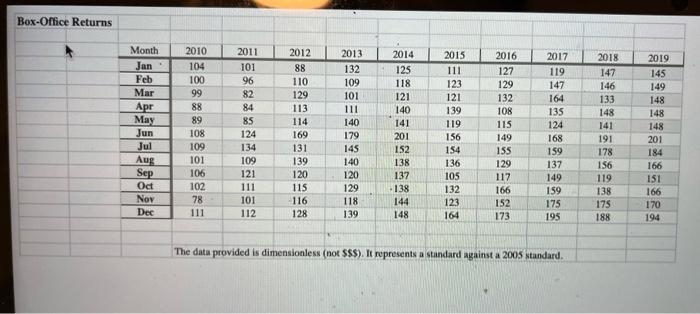Answered step by step
Verified Expert Solution
Question
1 Approved Answer
Case Study 2: Forecasting Box Office Returns For years, people in the motion picture industry critics, film historians, and others have eagerly awaited the second
Case Study 2: Forecasting Box Office Returns
For years, people in the motion picture industry critics, film historians, and others have eagerly awaited the second issue in January of Variety. Long considered the show business bible, Variety is a weekly trade newspaper that reports on all aspects of the entertainment industry; movies, television, recordings, concert tours, and so on. The second issue in January, called the Anniversary Edition, summarizes how the entertainment industry fared in the previous year, both artistically and commercially.
In this issue, Variety publishes its list of All Time Film Rental Champs. This list indicates, in descending order, motion pictures and the amount of money they returned to the studio. Because a movie theater rents a film from a studio for a limited time, the money paid for admission by ticket buyers is split between the studio and theater owner. For example, if a ticket buyer pays $12 to see a particular movie, the theater owner keeps about $6 and the studio receives the other $6. The longer a movie plays in a theater, the greater the percentage of the admission price returned to the studio. A film playing for an entire summer could eventually return as much as 90% of the $12 to the studio. The theater owner also benefits from such a success because although the owners percentage of the admission price is small, the sales of concessions (candy, soda and so on) provide greater profits. Thus, both the studio and the theater owner win when a film continues to draw audiences for a long time. Variety lists the rental figures (the actual dollar amounts returned to the studios) that the films have accrued in their domestic releases (United States and Canada).
In addition, Variety provides a monthly Box-Office Barometer of the film industry, which is a profile of the months domestic box-office returns. This profile is not measured in dollars but scaled according to some standard. By the late 2000s, for example, the scale was based on numbers around 100, with 100 representing the average box-office return of 2005. The figures from 2010 to 2019 are given in the table below and in the file BoxOffice.xlsx in blackboard.
All the figures are scaled around the 2005s box-office returns, but instead of dollars, artificial numbers are used. Film executives can get a relative indication of the box-office figures compared to the arbitrary 2005 scale. For example, in January 2010 the box-office returns to the film industry were 95% of the average that year, whereas in January 2011 the returns were 104% of the average of 2005 (or, they were 4% above the average of 2005s figure).
From the time series given in the above table, you will make a forecast for the 12 months of the next FULL calendar year, 2020.
Managerial Report is due on Thursday, 15 Sept (40 pts)
1.Produce a time series plot of the data. From this graph, do you see a pattern? Can you see any seasonality in the data?
Make 2 plots; first with all 10 years together, the other with each year individually
2.Use exponential smoothing to fit the data. Select an appropriate constant based on the variation you see in the data. Comment on the appropriateness of exponential smoothing on this data set. Plot the predictions from this model on the graph with the original data. How well does this technique fit the data? Make forecasts for each month in 2020.
How do you effectively use 10 years of data when exponential smoothing only forecasts that next period, in this case January 2020?
3.Use regression to build a linear trend model. Comment on the goodness-of-fit of this model to the data (or, how well does R2 explain the variance in the data?). Plot the predictions from this model on the graph with the original data.
4.Develop multiplicative seasonal indices for the linear trend model developed in question ---Use these indices to adjust predictions from the linear trend model from question 3 above for seasonal effects. Plot the predictions from this model on the graph with the original data. How well does this technique fit the data? Make forecasts for the next 12 months of 2020 using this technique.
5.Which forecasting method of those that you tried do you have the most confidence for making accurate forecasts for 2020? Use MAPE (mean absolute percent error) as your criterion to justify your decision.
Remember: using accuracy measures such as MAPE are computed against the known, actual data values you have with the respective forecasts for that period.

Step by Step Solution
There are 3 Steps involved in it
Step: 1

Get Instant Access to Expert-Tailored Solutions
See step-by-step solutions with expert insights and AI powered tools for academic success
Step: 2

Step: 3

Ace Your Homework with AI
Get the answers you need in no time with our AI-driven, step-by-step assistance
Get Started


